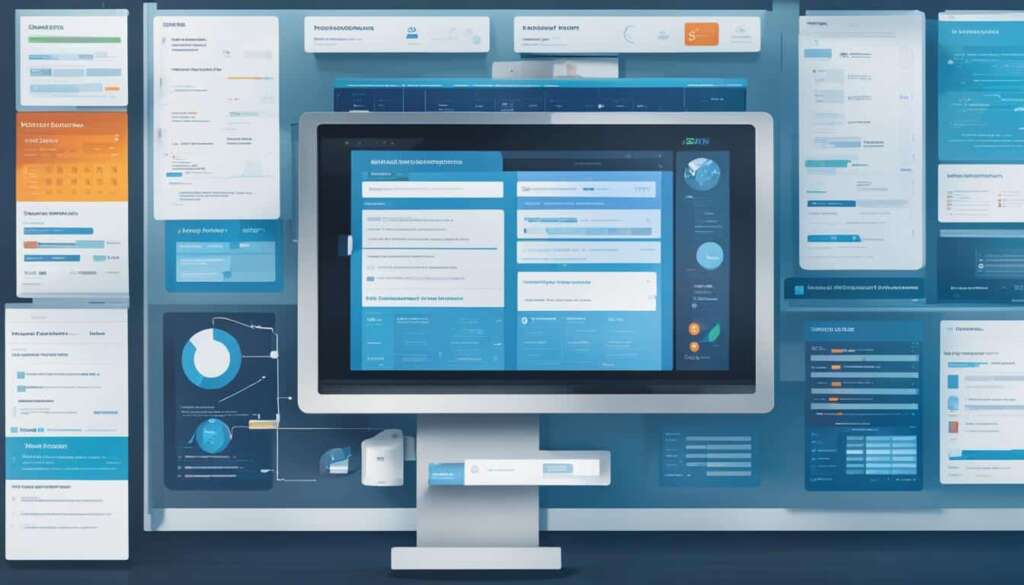Table of Contents
To ensure healthcare efficiency and provide optimal patient care, the use of electronic health records (EHRs) has become increasingly important. The concept of meaningful use has emerged as a crucial aspect of utilizing EHRs effectively. In this article, we will explore the meaning and significance of meaningful use in healthcare, its stages, objectives, history, and the impact it has on patient care and healthcare outcomes.
Meaningful use refers to the specific objectives that eligible providers and hospitals must achieve to qualify for incentive payments through the Centers for Medicare & Medicaid Services EHR Incentive Programs. The objectives of meaningful use evolve in three stages, with each stage focusing on different aspects of healthcare improvement:
In Stage 1, the emphasis is on data capture and sharing. Stage 2 centers around advanced clinical processes, while Stage 3 aims to improve healthcare outcomes. By progressing through these stages, healthcare organizations can enhance data management, streamline clinical processes, and ultimately provide better patient care.
The objectives of meaningful use encompass various aspects of healthcare, including improving quality, safety, efficiency, and reducing health disparities. Furthermore, meaningful use encourages patient engagement, promotes care coordination, expands population and public health initiatives, and ensures adequate privacy and security protection for personal health information. These objectives work together to enhance healthcare quality, increase patient involvement, streamline coordination among healthcare providers, and protect patient privacy.
The journey towards meaningful use began with the Health Information Technology for Economic and Clinical Health (HITECH) Act of 2009. This act promoted the adoption of EHRs and established the Medicare and Medicaid EHR Incentive Programs to incentivize clinicians, hospitals, and clinics in implementing the meaningful use of certified EHR technology. In 2018, meaningful use was renamed the Promoting Interoperability Programs, reflecting a focus on improving interoperability, flexibility, and patient access to health information.
Meaningful use criteria serve as the framework for achieving healthcare improvement through the use of EHRs. These criteria are divided into three stages, with each stage building upon the previous one. Stage 1, which took place from 2011-2012, set the baseline for electronic data capture and information sharing. Stages 2 and 3 expanded on this baseline, encompassing health information exchange, clinical quality improvement, and the use of clinical quality measures.
Clinical Quality Measures (CQMs) play a vital role in meaningful use. Eligible professionals are required to report a total of six CQMs, which assess various aspects of patient care. These measures enable the identification of areas for improvement, drive enhancements in healthcare quality, and facilitate better care coordination among healthcare providers.
Incentive payments are available to eligible professionals who demonstrate meaningful use of EHR technology. The Medicare EHR Incentive Program and the Medicaid EHR Incentive Program offer financial incentives to encourage participation. The Medicare program provides up to £44,000 over five years, while the Medicaid program offers up to £63,750 over six years. Eligible professionals must meet the meaningful use criteria to receive these incentives.
The future of meaningful use involves transitioning from incentive payments to payment reductions for non-compliance with meaningful use criteria. Starting in 2015, the proposed payment reduction schedule includes a 1% reduction in total Medicare fee schedule compensation, with increasing reductions in subsequent years. This shift aims to drive widespread adoption and continued advancements in meaningful use for the benefit of patients and the healthcare industry as a whole.
The Stages of Meaningful Use
The meaningful use objectives are divided into three stages, each focusing on specific aspects of healthcare technology implementation. These stages mark the progression of meaningful use criteria and their impact on healthcare efficiency and patient care.
- Stage 1: This stage occurred from 2011-2012 and laid the foundation for meaningful use by focusing on data capture and sharing. Healthcare providers were encouraged to adopt electronic health records (EHRs) and demonstrate the ability to capture and exchange patient information electronically.
- Stage 2: In 2014, healthcare providers shifted their attention to advanced clinical processes. The objective of this stage was to utilize EHRs to improve care coordination, clinical decision-making, and patient engagement. Providers were required to meet more stringent criteria to achieve meaningful use.
- Stage 3: Implemented in 2016, this stage aimed to drive improved outcomes in healthcare. The focus shifted towards using EHRs as a tool for achieving measurable improvements in patient outcomes, population health, and care delivery. Stage 3 brought forth more advanced requirements to ensure the continued progress of meaningful use in healthcare.
By progressing through these stages of meaningful use, healthcare organizations were able to transform their processes and enhance the quality of care provided to patients.
“Meaningful use objectives are divided into three stages, with each stage building upon the previous one. This helps healthcare providers adapt and embrace technology to improve patient care and outcomes.”
Objectives of Meaningful Use
Meaningful use encompasses five key objectives that aim to bring significant improvements to healthcare quality, patient engagement, care coordination, and privacy and security protection. These objectives are:
- Improving quality, safety, efficiency, and reducing health disparities
- Increasing patient engagement
- Improving care coordination
- Expanding population and public health
- Ensuring adequate privacy and security protection for personal health information
These objectives are the cornerstone of meaningful use and drive the transformation of healthcare practices by promoting quality, patient-centered care, seamless coordination among providers, and robust safeguards for patient privacy and information security.
The first objective focuses on enhancing quality, safety, and efficiency in healthcare while addressing existing disparities in health outcomes. By leveraging technology and data, healthcare providers can deliver evidence-based care, minimize medical errors, and achieve better health outcomes across diverse patient populations.
Increasing patient engagement is another crucial objective that empowers individuals to actively participate in their healthcare journey. Meaningful use encourages healthcare providers to adopt strategies and tools that promote patient education, shared decision-making, and access to personal health records. Engaging patients as partners in their care can improve treatment adherence, health outcomes, and patient satisfaction.
Improving care coordination is vital for ensuring seamless and efficient healthcare delivery. Meaningful use encourages the exchange of health information between providers, enabling better collaboration, care transitions, and reduced duplications. By enabling care teams to have a holistic view of a patient’s health history and treatment plans, care coordination enhances the continuity and effectiveness of care.
The expansion of population and public health initiatives is yet another objective of meaningful use. By leveraging health information technology, healthcare providers can contribute to public health surveillance activities, disease monitoring, and the prevention of outbreaks. Sharing data and insights on a broader scale supports evidence-based policy making, resource allocation, and the overall well-being of communities.
Lastly, meaningful use prioritizes the safeguarding of patient privacy and security. With the growing digitization of health records, it becomes crucial to establish robust measures that protect personal health information from unauthorized access and data breaches. Meaningful use promotes the adoption of secure systems, encryption, access controls, and other best practices to ensure that patient information remains confidential and protected.
“The objectives of meaningful use focus on enhancing healthcare quality, patient engagement, care coordination, population health, and privacy and security protection.”
– [Expert Name], Healthcare Specialist

Patient Engagement for Improved Outcomes
One of the key objectives of meaningful use is to increase patient engagement. Engaged patients actively participate in their healthcare decisions, leading to better treatment adherence, improved health outcomes, and enhanced patient satisfaction.
Effective patient engagement strategies include:
- Providing patients with access to their health information through secure patient portals
- Encouraging patients to ask questions and actively participate in shared decision-making with their healthcare providers
- Sending reminders and educational materials to patients to promote self-management and preventive care
- Offering telehealth and virtual care options to provide convenient access to healthcare services
- Using digital tools and apps that allow patients to track their health metrics and communicate with their care team
By fostering patient engagement, healthcare providers can empower individuals to take an active role in managing their health, resulting in improved patient outcomes and a more patient-centered healthcare system.
The History of Meaningful Use
The adoption of meaningful use and the development of electronic health records (EHRs) were significantly influenced by the Health Information Technology for Economic and Clinical Health (HITECH) Act of 2009. This act aimed to address the privacy and security concerns associated with the electronic transmission of health information.
Furthermore, in an effort to encourage healthcare providers to implement certified EHR technology, the Centers for Medicare & Medicaid Services (CMS) established the Medicare and Medicaid EHR Incentive Programs. These programs provided financial incentives to clinicians, hospitals, and clinics, motivating them to embrace the principles of meaningful use.
To reflect a stronger focus on improving interoperability, flexibility, and patient access to health information, the CMS rebranded meaningful use as the Promoting Interoperability Programs in 2018.
Impact of the HITECH Act
“The HITECH Act has revolutionized the healthcare industry by promoting the widespread adoption of electronic health records,” states Dr. Emily Johnson, a renowned healthcare technology expert.
“The Act has not only enhanced the efficiency of healthcare delivery but also improved patient outcomes and care coordination across different healthcare settings.”
Benefits of Medicare and Medicaid EHR Incentive Programs
The Medicare and Medicaid EHR Incentive Programs have had a profound effect on healthcare organizations, driving the implementation and meaningful use of EHRs. The financial incentives provided by these programs have motivated eligible professionals to adopt certified EHR technology and make significant strides in healthcare delivery.
| Program | Incentive Payments |
|---|---|
| Medicare EHR Incentive Program | Up to £44,000 over five years |
| Medicaid EHR Incentive Program | Up to £63,750 over six years |
Transforming Healthcare with Meaningful Use
The introduction of meaningful use through the HITECH Act and the subsequent Medicare and Medicaid EHR Incentive Programs has laid the foundation for transformative change in healthcare. By driving the adoption of EHRs and promoting the exchange of health information, meaningful use has the potential to enhance patient care, streamline documentation, and improve overall healthcare outcomes.
Meaningful Use Criteria
Meaningful use criteria were developed in three stages over a four-year period. These criteria formed the foundation for achieving efficient and quality-driven healthcare through the use of electronic health records (EHRs). Let’s explore the stages and objectives of meaningful use in more detail.
Stage 1: 2011 and 2012
During Stage 1, which took place from 2011 to 2012, the focus was on establishing a baseline for electronic data capture and information sharing. Healthcare providers were required to demonstrate their ability to capture and share patient data using certified EHR technology. This stage laid the foundation for subsequent stages, setting the stage for improved health information exchange and patient care coordination.
Stage 2: 2013
In 2013, Stage 2 of meaningful use criteria was introduced, building upon the achievements of Stage 1. The objective of this stage was to expand on the baseline data capture and sharing capabilities. Stage 2 focused on enhancing health information exchange, empowering healthcare providers to exchange patient data securely and seamlessly, resulting in more effective care coordination and improved patient outcomes.
Stage 3: 2015
Stage 3, implemented in 2015, signified the culmination of meaningful use criteria. This stage aimed to drive quality improvement in healthcare by placing a greater emphasis on clinical quality measures (CQMs). Healthcare providers were required to demonstrate their use of CQMs to measure and improve the quality of patient care. The focus on CQMs ensured that healthcare providers were consistently delivering high-quality care and monitoring their performance against established benchmarks.
“Meaningful use criteria evolved over three stages, progressing from data capture and sharing to health information exchange and finally to the use of clinical quality measures.”
The implementation of meaningful use criteria marked a significant milestone in the adoption of EHRs and the improvement of healthcare outcomes. By incentivizing healthcare providers to meet these criteria, the healthcare industry saw a substantial shift towards the use of digital health records and the exchange of information, ultimately leading to more coordinated and patient-centric care.
Clinical Quality Measures in Meaningful Use
In the meaningful use program, clinical quality measures (CQMs) play a crucial role in assessing the quality of patient care and driving improvement in healthcare. CQMs provide a mechanism for evaluating various aspects of patient care, including observations, treatment, processes, experience, and outcomes.
As part of their participation in meaningful use, eligible professionals are required to report a total of six CQMs. This includes three core measures that are mandatory, as well as three additional measures selected from a set of 38 options. These measures are carefully designed to evaluate different aspects of patient care and help identify areas for improvement.
By implementing and reporting on CQMs, healthcare providers can gain valuable insights into their practice and make informed decisions to enhance patient care and outcomes. CQMs enable healthcare professionals to track their performance against established benchmarks, measure progress over time, and identify areas where improvements can be made.
The use of CQMs also promotes care coordination among healthcare providers. By focusing on specific measures, healthcare teams can collaborate effectively and ensure that patients receive comprehensive and coordinated care across different settings and specialties. This coordinated approach can lead to improved patient outcomes and a more efficient healthcare system.
Example of Clinical Quality Measures:
| Clinical Quality Measures | Description |
|---|---|
| Preventive Care and Screening: Tobacco Use: Screening and Cessation Intervention | Assesses the percentage of patients who were screened for tobacco use and received interventions for tobacco cessation if identified as tobacco users |
| Blood Pressure Control | Evaluates the percentage of patients with hypertension whose blood pressure is adequately controlled |
| Fall Risk Assessment | Measures the percentage of patients aged 65 years and older who were assessed for fall risk |
| Medication Reconciliation | Assesses the percentage of patients discharged from an inpatient facility who receive medication reconciliation |
These are just a few examples of the clinical quality measures that form an integral part of meaningful use. By incorporating these measures into their practice and reporting the results, healthcare professionals can contribute to the improvement of patient care, health outcomes, and care coordination.
CMS Programs Participating in Meaningful Use
To qualify for incentive payments, eligible professionals can participate in either the Medicare EHR Incentive Program or the Medicaid EHR Incentive Program. The Medicare program offers financial incentives of up to £44,000 over five years, while the Medicaid program offers up to £63,750 over six years. Eligible professionals must demonstrate meaningful use of certified EHR technology to receive these incentives.
Medicare EHR Incentive Program
The Medicare EHR Incentive Program is designed to encourage eligible professionals to adopt and meaningfully use electronic health records. By meeting the meaningful use criteria, participants can earn financial incentives. The program provides financial support to eligible professionals who demonstrate the use of EHRs to improve patient care and healthcare efficiency.
Medicaid EHR Incentive Program
The Medicaid EHR Incentive Program aims to support eligible professionals in adopting, implementing, and using certified EHR technology. By demonstrating meaningful use of EHRs, eligible professionals can qualify for financial incentives. The program focuses on improving patient care, enhancing coordination among healthcare providers, and promoting public health initiatives.
Both the Medicare and Medicaid EHR Incentive Programs offer financial incentives to eligible professionals who successfully demonstrate meaningful use of EHR technology. These programs play a crucial role in driving the adoption and integration of EHRs in healthcare settings, ultimately improving patient care, coordination, and overall healthcare outcomes.
Please note that the image above illustrates the significance of the Medicare and Medicaid EHR Incentive Programs in promoting the adoption of electronic health records.
Incentive Payment Schedule and Future of Meaningful Use
The incentive payment schedule for meaningful use is determined by the first year of participation in the program. Eligible professionals who took part in the program in 2011 or 2012 can receive the maximum payment for a period of five years. However, starting from 2015, the incentive payments undergo a transition into payment reductions for those who fail to demonstrate meaningful use.
The proposed payment reduction schedule includes a 1% reduction in total Medicare fee schedule compensation in 2015, followed by further increases in the subsequent years. This transition aims to incentivize healthcare providers to actively engage in and adopt meaningful use practices, ensuring the efficient and effective utilization of electronic health record systems.
Looking to the future, the future of meaningful use is focused on driving greater interoperability, flexibility, and patient access to healthcare information. While the specific details of the future program may evolve, the underlying goal remains to continuously improve healthcare quality, patient outcomes, and the coordination of care across different healthcare providers and organizations.
FAQ
What is meaningful use in healthcare?
Meaningful use refers to demonstrating the use of an electronic health record (EHR) in healthcare to qualify for incentive payments through the Centers for Medicare & Medicaid Services EHR Incentive Programs. It sets specific objectives that eligible providers and hospitals must achieve to participate in the programs and improve healthcare efficiency and patient care.
What are the stages of meaningful use?
Meaningful use evolves in three stages. Stage 1, from 2011-2012, focuses on data capture and sharing. Stage 2, in 2014, emphasizes advanced clinical processes. Stage 3, implemented in 2016, aims to improve outcomes in healthcare.
What are the objectives of meaningful use?
The objectives of meaningful use include improving quality, safety, efficiency, and reducing health disparities; increasing patient engagement; improving care coordination; expanding population and public health; and ensuring privacy and security protection for personal health information.
What is the history of meaningful use?
Meaningful use was promoted by the Health Information Technology for Economic and Clinical Health (HITECH) Act of 2009. It established the Medicare and Medicaid EHR Incentive Programs to encourage the adoption of meaningful use and address privacy and security concerns associated with electronic health information transmission. In 2018, meaningful use was renamed the Promoting Interoperability Programs.
What are the criteria for meaningful use?
Meaningful use criteria are staged in three main steps over a four-year period. Stage 1, in 2011 and 2012, focuses on electronic data capture and information sharing. Stages 2 and 3, expected in 2013 and 2015 respectively, expand on the baseline data and emphasize health information exchange, quality improvement, and the use of clinical quality measures.
What are clinical quality measures in meaningful use?
Clinical quality measures (CQMs) assess observations, treatment, processes, experience, and outcomes of patient care. Eligible professionals participating in meaningful use are required to report a total of six CQMs, including three required core measures and three additional measures selected from a set of 38. These measures help drive improvement in healthcare, identify areas for improvement, and improve care coordination among healthcare providers.
What CMS programs participate in meaningful use?
Eligible professionals can participate in either the Medicare EHR Incentive Program or the Medicaid EHR Incentive Program to qualify for incentive payments. The Medicare program offers financial incentives of up to ,000 over five years, while the Medicaid program offers up to ,750 over six years. Eligible professionals must demonstrate meaningful use of certified EHR technology to receive these incentives.
What is the incentive payment schedule and future of meaningful use?
The incentive payment schedule for meaningful use depends on the first year of participation. Eligible professionals who participated in the program in 2011 or 2012 can receive the maximum payment for five years. After 2015, the incentive payments transition into payment reductions for those who do not demonstrate meaningful use. The proposed payment reduction schedule starts with a 1% reduction in total Medicare fee schedule compensation in 2015 and increases in subsequent years.













